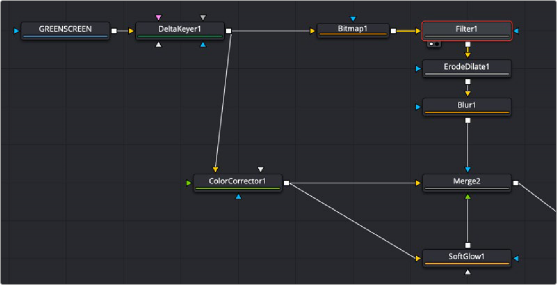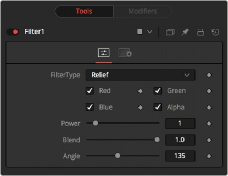
< Previous | Contents | Next >

The Filter node
Filter Node Introduction
The Filter node contains several standard convolution filters, easily selectable from a list. This node enables a variety of effects, from radically changing the look of an image to adding subtle randomly- generated film grain. The Sobel and Laplacian settings are often used for edge detection.
Inputs
The Filter node includes two inputs: one for the main image and the other for an effect mask to limit the area where the filter is applied.
— Input: The orange input is used for the primary 2D image that gets the filter applied.
— Effect Mask: The optional blue effect mask input accepts a mask shape created by polylines, basic primitive shapes, paint strokes, or bitmaps from other tools. Connecting a mask to this input limits the filter to only those pixels within the mask. An effects mask is applied to the tool after the tool is processed.
![]()
Basic Node Setup
The Filter node can be inserted after an image, mask, or any node that needs a filter applied. Below, it is used to create an edge matte, which is then used to mask the soft glow around the keyed foreground.

A Filter node using the Sobel setting to extract an edge matte
Inspector

Filter controls
Controls Tab
The Controls tab is used to set the filter type, the channels the filter is applied to, and the amount it blends with the original image.
The Filter Type menu provides a selection of filter types described below.
— Relief: This appears to press the image into metal, such as an image on a coin. The image appears to be bumped and overlaid on gray.
— Emboss Over: Embosses the image over the top of itself, with adjustable highlight and shadow height and direction.
![]()
— Noise: Uniformly adds noise to images. This is often useful for 3D computer-generated images that need to be composited with live action, as it reduces the squeaky-clean look that is inherent in rendered images. The frame number acts as the random generator seed. Therefore, the effect is different on each frame and is repeatable.
— Defocus: This filter type blurs the image.
— Sobel: Sobel is an advanced edge detection filter. Used in conjunction with a Glow filter, it creates impressive neon light effects from live-action or 3D-rendered images.
— Laplacian: Laplacian is a very sensitive edge detection filter that produces a finer edge than the Sobel filter.
— Grain: Adds noise to images similar to the grain of film (mostly in the midrange). This is useful for 3D computer-generated images that need to be composited with live action as it reduces the squeaky-clean look that is inherent in rendered images. The frame number acts as the random generator seed. Therefore, the effect is different on each frame and is repeatable.
The Filter node defaults to operating on R, G, B, and A channels. Selective channel editing is possible by enabling or disabling the checkboxes beside each channel.
Values range from 1 to 10. Power proportionately increases the amount by which the selected filter affects the image. This does not apply to the Sobel or Laplacian filter type.